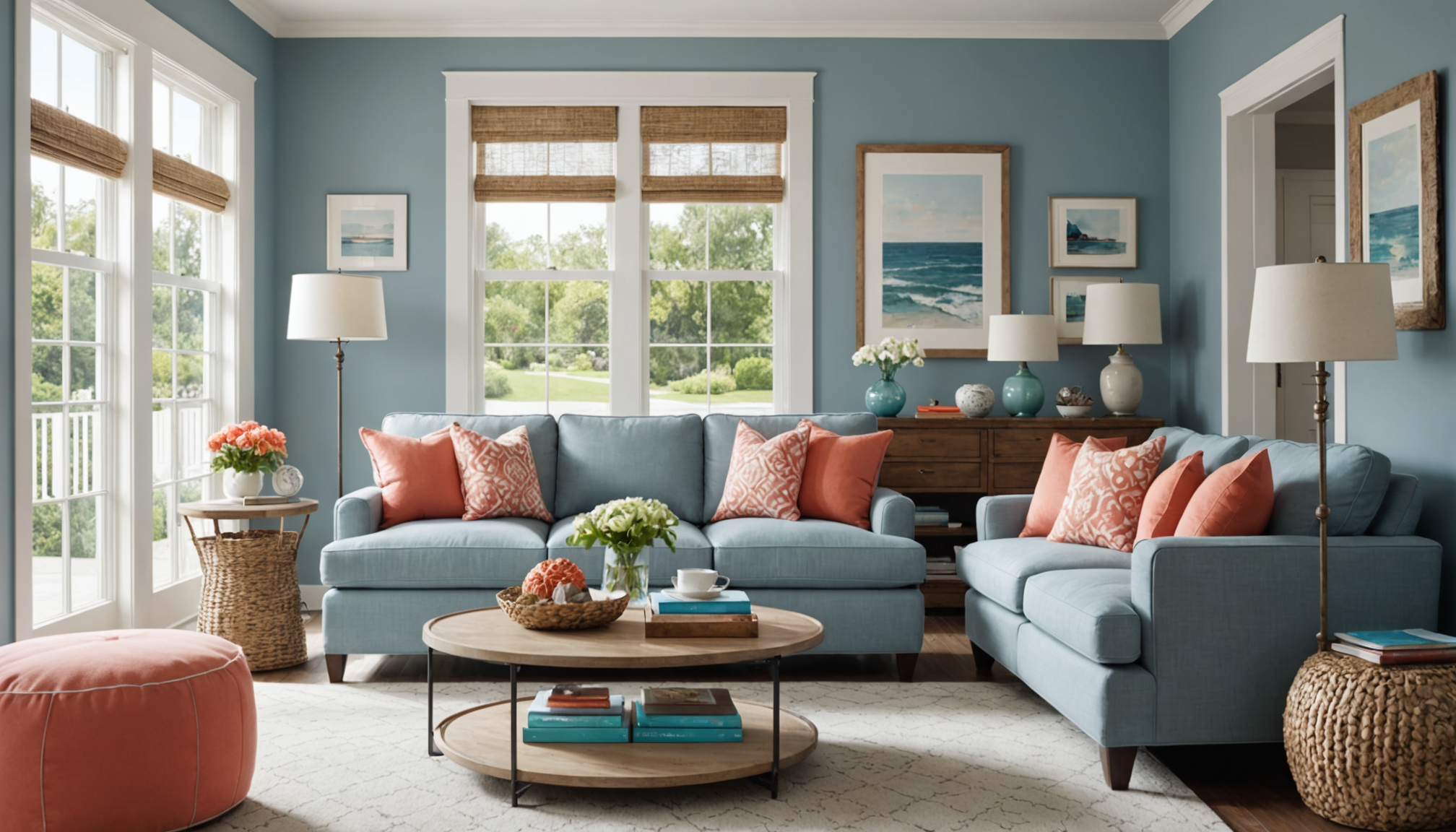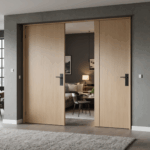When setting the mood and aesthetic for your living room, selecting an appropriate color palette plays a vital role. Colors have the power to influence not just the ambiance of the room, but also the mood of its occupants. Whether you’re aiming to evoke a sense of calm, energy, or sophistication, the right colors can make all the difference. For those looking to decorate their living room without entirely overturning the existing decor, color can be a transformative tool.
To start, consider what kind of atmosphere you want to establish in your living room. Are you looking for a cozy and inviting space, or perhaps something more modern and stimulating? Once you have a vision for your desired ambiance, it’s time to explore color options that align with your goals. Homeowner tips suggest focusing not just on aesthetics, but also on how colors can interact with the natural and artificial lighting, furniture, and decor already present in the room.
One effective technique is to use a base color that serves as the backbone of your palette. Neutral tones such as greys, taupes, or whites work well as foundational colors. These colors offer flexibility as they can easily blend with different shades, making future updates or redecorating simpler without starting from scratch.
- Accent Colors: These are typically more vibrant hues that are used sparingly to add interest and highlights within the room. They can be introduced through textiles like cushions or curtains, or through artwork and other decorative accessories.
- Complementary Colors: These colors are opposite each other on the color wheel and can create a pleasing contrast and balance within the room. For example, pairing a soft blue with warm orange accents can create a stunning, dynamic look.
For those unsure about which palette to embrace, hiring pros such as interior decorators can offer tailored advice based on a comprehensive analysis of your space. These professionals have a keen eye for color harmony and can suggest combinations that may not be immediately apparent to non-experts.
Here’s a simple comparison of popular living room color palettes to consider:
| Palette Name | Primary Color | Accent Colors | Suitable Style |
| Coastal Retreat | Light Blue | Sand Beige, Coral | Beach House, Nautical |
| Urban Chic | Charcoal Grey | Mustard Yellow, Teal | Modern, Industrial |
| Classic Elegance | Ivory | Burgundy, Gold | Traditional, Victorian |
Balancing color with lighting is essential. Some hues may appear different under varying lights, and what looks perfect in the paint store might change at home. Testing paint samples on your walls during different times of the day can provide insight into how color changes with light, ensuring the security of your choice. This method allows for better decision-making, enhancing the cohesiveness of your decorating journey.
selecting the perfect furniture
Selecting the perfect furniture for your living room is a critical step in shaping the overall atmosphere and functionality of the space. Whether you are aiming for comfort, style, or a mix of both, choosing the right pieces can transform your living room into a welcoming and cohesive area. Here’s a step-by-step guide to help you through the process:
1. Assess Your Needs:
– Begin by evaluating the primary purpose of your living room. Is it a space for entertaining guests, relaxing with family, or perhaps a versatile area that combines various activities? Your needs will guide your furniture choices.
– Consider the number of people who will use the room regularly. A large family might require more seating options, whereas a couple might prioritize a cozy sofa or sectional.
2. Measure the Space:
– Accurate measurements are key to ensuring your furniture fits well without overwhelming the space or hindering movement.
– Measure the dimensions of your living room, including length, width, and height. Note any architectural features like windows, doors, and outlets that might influence furniture placement.
– Create a floor plan or use an online room planner tool to visualize different layout options before making any purchases.
3. Determine Your Style:
– Reflect on the style you want to achieve. Do you prefer modern minimalism, rustic charm, or classic elegance?
– Draw inspiration from the current decor elements, such as the color palette you’ve chosen, to maintain a harmonious look.
– Homeowner tips suggest browsing design magazines, websites, or social media platforms such as Pinterest to gather ideas and identify your preferred style.
4. Choose Key Pieces:
– Start with essential furniture pieces like sofas, chairs, and tables, which will form the foundation of your living room.
– Sofas: Consider comfort and quality. A sofa serves as the centerpiece, so choose one that offers durability, style, and adequate seating. Options like sectionals can be ideal for larger spaces or open-plan designs.
– Chairs: Select complementary chairs to balance seating capacity. Accent chairs can add a pop of color or texture and help tie the room together.
– Invest in multipurpose furniture if space is limited or if you want added functionality, such as a sofa bed or a coffee table with storage.
5. Consider Material and Fabric:
– Take into account the usage and maintenance of each piece. If you have children or pets, opt for materials and fabrics that offer greater resistance to wear and tear, such as leather or microfiber.
– Explore sustainable or eco-friendly options if that aligns with your values.
6. Balance Aesthetics and Functionality:
– While it’s essential to choose furniture that matches your style, don’t compromise on comfort and practicality.
– Test seats for comfort and check for features like removable cushion covers or adjustable backrests that enhance usability.
7. Create a Budget:
– Determine a budget for your living room furniture and stick to it as much as possible, allowing some flexibility for must-have items.
– It may be worth hiring pros like an interior designer to help allocate your budget efficiently, making sure you invest in pieces that add the most value to your living room in terms of design and utility.
8. Finalize and Arrange:
– Once you’ve made your selections, arrange your furniture according to your floor plan to maximize the flow and enhance the room’s functionality.
– Keep walkways clear to improve movement security and avoid clutter by ensuring storage needs are met.
By carefully considering these steps, you can select furniture that not only reflects your personal style but also enhances the living room’s comfort and utility for years to come.
enhancing with lighting
Lighting plays a transformative role in any living room, not just by illuminating the space but by highlighting its best features and adding depth and warmth. A well-thought-out lighting scheme can shift the ambiance from cozy to lively or from traditional to contemporary, depending on your mood or the occasion.
When approaching a lighting plan, start by considering the general or ambient lighting. This forms the base layer, providing overall illumination for everyday activities and ensuring the comfort and security of your household. Overhead fixtures such as chandeliers, recessed lights, or ceiling mounts often serve this purpose. If you want to decorate with a touch of sophistication, opt for fixtures with unique designs or intricate details that reflect your style.
Task lighting is essential for specific activities like reading or working at a desk. Floor or table lamps placed near sofas, chairs, or desks can provide focused light without detracting from the room’s atmosphere. Consider adjustable lamps to provide flexibility and ensure that light reaches the exact area you need. Homeowner tips suggest using LED bulbs, as they offer excellent energy efficiency and long-lasting illumination, perfect for task lighting that’s often in use.
Accent lighting serves as the creative expression within your lighting plan. Its primary purpose is to highlight artwork, architectural features, or decorative accessories and create focal points that draw attention to your living room’s unique elements. This can be achieved with spotlights, wall sconces, or track lighting. To enhance the drama, you might experiment with dimmable options or colored bulbs, allowing you to evoke varying moods and adapt the look of your space easily.
Layering different types of lighting is vital to achieving a balanced and versatile living room. Experiment by using a combination of fixtures at various heights, like sconces paired with floor lamps, to create a sense of depth. Adjusting the illumination at different times of the day allows the room’s character to evolve, providing a dynamic living environment.
Pay attention to the role of natural light when planning your lighting decor. Large windows or strategically placed mirrors can amplify daylight, reducing the need for artificial lighting during the daytime. This not only conserves energy but enhances the room’s openness and freshness. Introducing sheer curtains or blinds offers privacy without sacrificing light, tying the elements of your decor into a seamless and functional whole.
Incorporating these lighting strategies ensures your living room isn’t just a functional space but a personalized haven that caters to your needs and preferences. Whether you’re having a quiet evening in or hosting a lively gathering, proficient lighting design empowers you to tailor the environment precisely and stylishly.
incorporating decorative accessories
Decorative accessories are the subtle actors that can turn a well-designed living room into a visually striking and personalized space. They serve as the final layer that weaves the various elements of the room together, adding visual interest and a touch of personality. The key to effectively incorporating these accessories is to strike a balance between style and function, ensuring that they complement rather than overwhelm the space.
Begin by identifying the feel you desire for your living room. Do you want it to be serene and understated or vibrant and eclectic? This decision will guide your choice of accessories and help you create a consistent theme. Consider the style of your existing furniture and color palette, as they will inform the types of decorative elements that will enhance your space.
Art pieces, whether large canvases, sculptural items, or a curated gallery wall, serve as focal points and are excellent additions to any living room. These items don’t just reflect your taste and personality, but they also offer conversation starters for when guests visit. To maximize their impact, place them at eye-level and ensure they’re adequately lit, perhaps by including some of the accent lighting strategies previously discussed.
Textiles such as throw pillows, blankets, and rugs are functional accessories that add warmth, texture, and color to your living room. Switch them out seasonally to refresh the space without committing to a significant decor overhaul. Choose materials that align with the usage and maintenance required, keeping in mind any security concerns such as slip-resistant rugs in homes with children or pets.
Vases, bowls, and other tabletop decor provide an excellent opportunity to introduce organic and dynamic elements. Incorporate live or faux plants to bring a sense of vitality and nature into your room. Greenery not only enhances visual appeal but also purifies the air, contributing to a healthy living environment. Select planters that match your room’s style—whether sleek and modern or rustic and earthy—to complete the ensemble.
Mirrors can be strategic accessories as well, particularly in smaller living rooms. They reflect light, magnifying the space, and can be used to focus attention on key areas. Decorative mirrors double as art pieces and can be placed strategically to create symmetry or enhance architectural features.
Don’t shy away from personality-rich accessories like books, travel souvenirs, or collectibles. These elements infuse the living room with character and charisma, making it truly yours. Aim for variety in the textures and shapes of your accessories to maintain visual interest and prevent the setting from appearing too uniform.
Finally, when arranging accessories, consider the principles of scale and proportion to avoid creating clutter. Group smaller items in odd numbers and vary their heights for a balanced look. Homeowner tips suggest stepping back periodically to assess the overall composition, allowing flexibility to make adjustments for a harmonious setup.
By thoughtfully weaving decorative accessories into your living room decor, you’re not only enhancing its aesthetic appeal but also creating a space that feels uniquely yours. Don’t hesitate to seek inspiration from various home design sources or even consider hiring pros if you want expert advice tailored to achieving your vision.
creating a functional layout
Creating a functional layout is crucial in harmonizing the aesthetic appeal with the practical use of your living room. The layout defines not only how your space looks but also how it feels and functions throughout everyday activities and special occasions. Essential homeowner tips here highlight the need to consider both foot traffic flow and the ease of movement as you decide on placements.
Start with understanding the primary purpose of your living room. Is it a tranquil retreat for reading and relaxation, or a lively space for entertaining guests? Your layout should accommodate these uses. Establish distinct zones within the room to cater to different activities—like a conversation area with sofas and chairs, and perhaps a reading nook with bookshelves and a cozy armchair.
Pay special attention to your room’s entrance points, ensuring the space doesn’t feel cramped and visitors can comfortably enter and navigate without bumping into furniture. This involves keeping pathways clear and direct, especially for frequently accessed areas. Furniture arrangements should promote easy interaction; for instance, arrange seating to face each other to facilitate conversation.
The scale and proportion of your furnishings are equally important. Avoid overwhelming smaller rooms with oversized pieces. Instead, embrace furniture that complements your living room’s size, such as a slender legged sofa or a scaled-down coffee table. You can further enhance openness by incorporating multi-functional furniture, like ottomans or nesting tables, that can adapt to various uses as needed.
To maximize the layout’s utility, consider placing your largest furniture item, like the sofa, against a focal point such as a fireplace, large window, or media center. This not only anchors the room but also directs the flow of its configuration. If your room allows, consider creating symmetrical arrangements for a formal vibe, or asymmetrical ones for a more relaxed and modern ambiance.
Storage solutions play a major role in maintaining a tidy and visually pleasing layout. Incorporate storage furniture like shelving units or sideboards that offer both function and style, allowing you to keep essentials close while maintaining a clutter-free surface. Decorative baskets or stylish storage boxes can house living room gadgets or kids’ toys, discreetly enhancing organization while adding a decorative touch.
Refresh your layout periodically to ensure it continues to meet any changing needs or preferences, especially if new elements are introduced or the family dynamic evolves. Kaleidoscopic versatility often comes by hiring pros who can offer a fresh perspective and innovative solutions for enhancing efficiency and rejuvenating the flow of your living space.
In conclusion, transforming your living room into a beautiful and functional area is all about balancing aesthetics, comfort, and utility. By carefully selecting a color palette that captures your desired mood, choosing furniture that complements and enhances the space, integrating lighting that highlights the room’s best features, and thoughtfully placing decorative accessories, you’ll create an inviting atmosphere. A well-planned functional layout ties these elements together, ensuring your living room is not just visually appealing but also a hub of comfort and activity. Embrace these strategies, and don’t hesitate to seek homeowner tips or professional advice for an even more personalized touch, creating a living room you’ll love for years to come.


